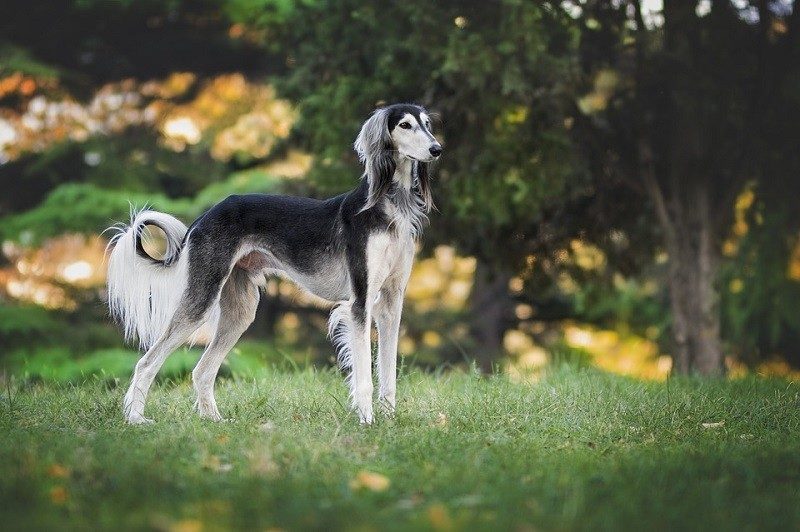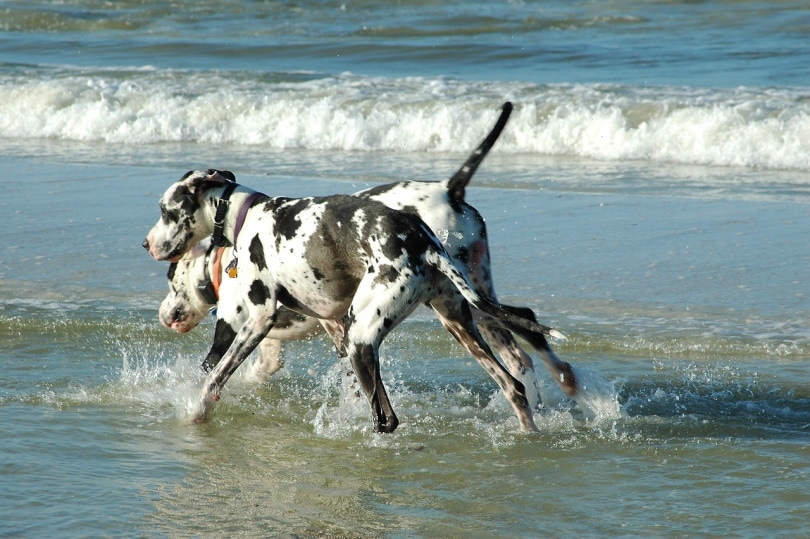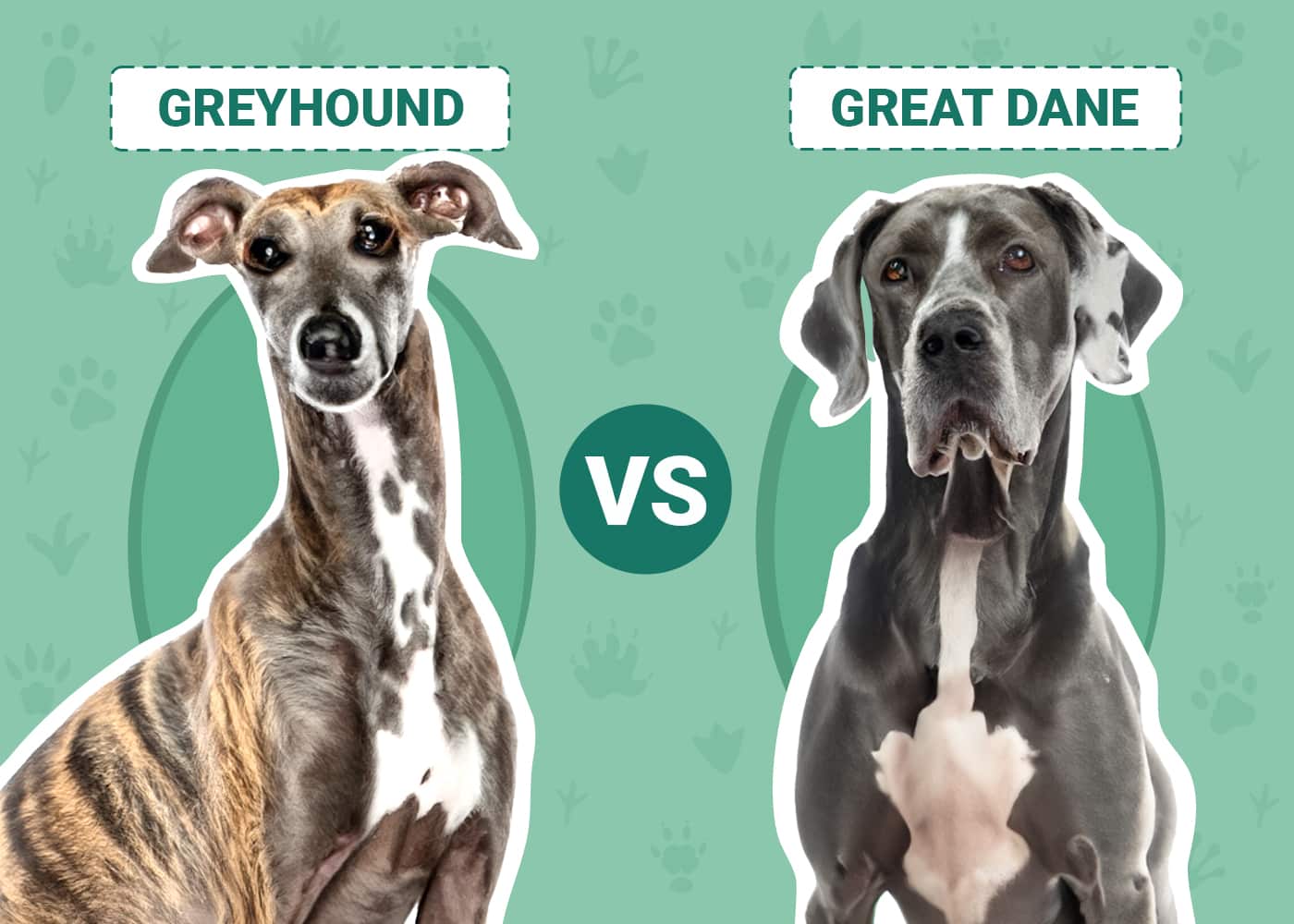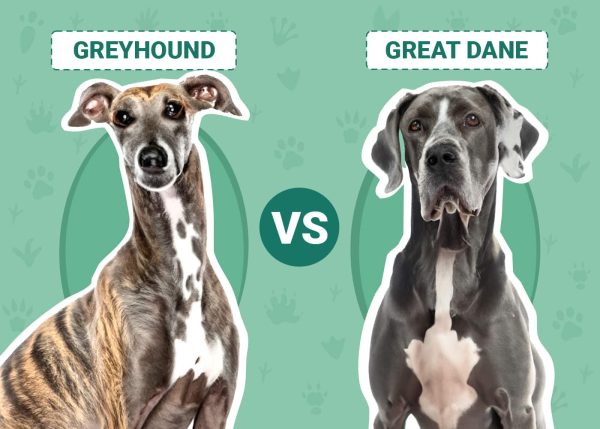Click to Skip Ahead
Greyhounds and Great Danes are beautiful and affectionate dog breeds. They’re both large and slender with short, easy-to-maintain coats. They have playful streaks and similar exercise requirements. That is where their similarities end, however.
Considered a giant breed, Great Danes are considerably larger than Greyhounds. They also lead much shorter lifespans, living as little as seven years, while Greyhounds can live to 15.
If you’re considering adopting one of these breeds, you need to familiarize yourself with their personalities, exercise needs, trainability, and health concerns. Keep reading to learn everything you need to know to make an informed decision about which breed would fit in best with your family and lifestyle.
Visual Differences

At a Glance
- Average height (adult): 25–30 inches
- Average weight (adult): 50–85 pounds
- Lifespan: 10–15 years
- Exercise: 1 hour a day
- Grooming needs: Low
- Family-friendly: Yes
- Other pet-friendly: Sometimes
- Trainability: Can be stubborn and distractible
- Average height (adult): 28–32 inches
- Average weight (adult): 110–175 pounds
- Lifespan: 7–10 years
- Exercise: 30–60 minutes a day (adult)
- Grooming needs: Low
- Family-friendly: Yes
- Other pet-friendly: Yes
- Trainability: Eager to please and easy to train

Greyhound Overview

Greyhounds are sighthounds, a type of dog that hunts primarily via sight and speed rather than by scent. They were bred for coursing, hunting, and greyhound racing. They have an instantly recognizable silhouette and an aerodynamic build that allows for plenty of speed. Greyhounds likely originated in Egypt, though there are mentions of the breed by Greeks and in Roman poetry.
Personality
A Greyhound’s personality may depend on its lineage, but most are even-tempered and mellow. They are often friendly and non-aggressive, though some may be aloof to strangers at first. However, a treat can change that pretty quickly, making Greyhounds quick to warm up to new people.
They are an intelligent and independent breed with a sensitive side. Greyhounds are often quick to react to any tensions they may sense in the home. However, they can also become shy and timid if they experience mistreatment, even if it is not intentional.
Greyhounds are very sweet but may have difficulty adapting to new situations. Therefore, potential owners should be prepared to be patient when introducing them to things like stairs, toys, or vehicles.
They have a very strong prey drive, so you may wish to rethink adopting a Greyhound if you have other small animals in your home.
Training & Exercise
Greyhounds have a high energy level and thrive in environments where they can live an active lifestyle, both physically and mentally. Families must be willing to give them high-energy activities and a healthy outlet for exercise.
Training Greyhounds can sometimes be challenging, as they are bred for independent pursuit and have a stubborn streak. Their sensitive side will make ineffective training techniques even more inefficient, so ensure you always use positive reinforcement during your training sessions.

Health
Greyhounds are a healthy and long-lived breed, living up to 15 years! However, they may be prone to certain inherited conditions and predisposed to some health issues.
Gastric dilatation and volvulus (GDV) can affect any dog breed with a deep chest. Gastric dilatation, sometimes better known as bloat, occurs after a large meal that causes the stomach to dilate. A combination of gas and food in the stomach can make it impossible for digested food to exit the stomach, increasing its pressure and size. This can lead to loss of blood flow, potential ruptures, diaphragm pressure, and irregular breathing. Bloat can be life-threatening, so immediate veterinary care if necessary if you notice symptoms of GDV.
Greyhounds may be prone to an inherited progressive neurological disorder known as polyneuropathy. This condition is linked to nerve dysfunction and is found in dogs whose both parents carry the genetic defect. Symptoms of this condition will usually begin manifesting between three to nine months.
Greyhounds are the only dog breed with a documented sensitivity to certain anesthesia drugs. This may result in prolonged recovery periods after anesthesia, even for routine procedures like dental cleanings.
The breed may also be prone to osteosarcoma, an aggressive form of bone cancer, and hypothyroidism.
Suitable For:
Greyhounds are a great pick for first-time pet owners. However, they are best suited for active homes. They do well in homes with children but may fare better in households with older children versus unpredictable and boisterous young ones. They can live harmoniously with other dogs, but their strong prey drive may cause problems if you have smaller animals.
Great Dane Overview

Great Danes are a working-class breed that originates from Germany. They descended from the hunting dogs people in the Middle Ages used to hunt wild deer and board. They often worked as guardians for the German nobility. The breed may date back to 3000 B.C., as drawings of similar dogs were found on Egyptian artifacts from that time.
Personality
Well-trained and well-bred Great Danes are one of the best-natured dog breeds. They are very gentle and affectionate pets that love to play. They sometimes think they’re lap dogs and are often referred to as “gentle giants.” They love to be where the family is and aren’t opposed to getting to know strangers.
Great Danes live well with other dogs, different animal species, and humans that are familiar to them. They generally don’t exhibit aggressiveness or a high prey drive, which is perfect for multi-pet and multi-species homes.
The Great Danes of centuries past were fearless boar hunters, but the ones we know and love today can have timid and anxious sides if they do not have proper socialization. You should prepare to expose your Great Dane puppy to a lot of new stimuli during the first few months of its life to help it live a fulfilling and fear-free life.
Training & Exercise
Great Danes are moderately playful and do need some space for daily exercise. If you live in a small apartment, you’ll need to take your pooch out for long walks twice a day to keep up with its exercise needs. Puppies and adolescents require more exercise, up to 90 minutes daily.
Great Danes can make great running partners, but you should wait until your pup is at least 18 months old. Before that point, their bones are still going through growth spurts and will not handle running well. Some aren’t even ready to start jogging until they are two years old.
Great Danes are people pleasers, so training them is relatively easy. However, they are fairly laid back, so you must let them lead your training sessions, as you can’t force them to do anything.

Health
Like the Greyhound, Great Danes are prone to developing gastric dilatation volvulus. This condition can become life-threatening in as little as 24 hours, so you must keep a close eye on your dog’s food intake and limit its exercise after meals. In addition, some owners opt to get a preventative surgery known as gastropexy to significantly reduce their pup’s risk of developing GDV.
Greyhounds are also prone to hip dysplasia. Your vet can take an x-ray to see if your pup is at risk of this condition and if so, an intervention may be required to help lessen the severity.
The long neck and large heads of Greyhounds may make them prone to a neurological condition known as wobbler syndrome. This disease affects the cervical spinal cord, resulting in neck pain and a wobbly gait. Wobbler syndrome is linked to nutrition, so you can reduce the likelihood of your dog developing it by feeding a high-quality large-breed-specific puppy diet until your dog is at least 18 months old.
The length of your Greyhounds tail may make it prone to happy tail syndrome. As cute as the name of this condition is, it can result in non-healing wounds and repeat trauma. Happy tail syndrome occurs when your dog’s long tail is constantly smacking on solid objects when it’s happy. Some owners need to surgically shorten their pup’s tail to reduce their risk.
It’s not just the head, neck, and tail of Greyhounds that are oversized. Their hearts are big, too, which may make them prone to dilated cardiomyopathy (DCM). This progressive disease affects the heart muscles, making it difficult to pump blood efficiently.
Suitable For?
Great Danes are suitable for active households that can provide the exercise necessary to keep them happy and healthy. They do best with experienced dog owners who can spend a lot of time with them. They can live in apartments, but potential owners need to take them outside for daily walks to ensure they stay physically active. They do well in homes with children and other pets, even non-canine ones.
Which Breed Is Right for You?
Greyhounds and Great Danes are both very beautiful dogs, but they’re not right for every home.
First, consider your experience level. Greyhounds are a great breed for first-time dog owners, but Great Danes are best for those with experience.
Next, think about your living arrangements. Do you have other pets or children? Due to their strong prey drive, Greyhounds may not be best for you if you have cats or other small animals. They can, however, get along with other dogs. Most Great Danes are gentle with cats and other small pets, provided you socialize them together properly.
Both breeds are kid-friendly, though Greyhounds do much better with older children than younger ones.
Finally, consider your commitment level. Greyhounds live much longer than Great Danes, so you must be prepared to spend the next 15 years with your canine pal.
No matter how you spin it, both breeds can make wonderful companions for the right households. With a little consideration and forethought, we’re sure you’ll make the right decision.
Featured Image Credit: (UP) Akiko Campbell, Pixabay | (Down) black-pearls, Pixabay












